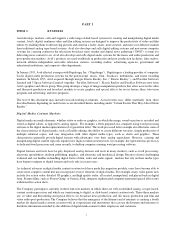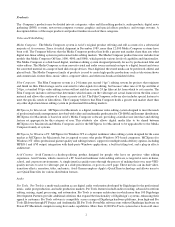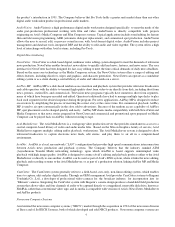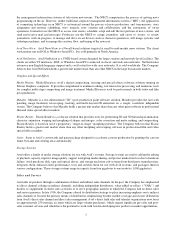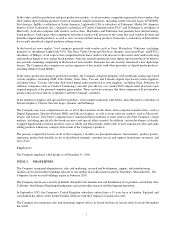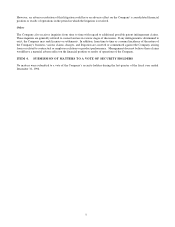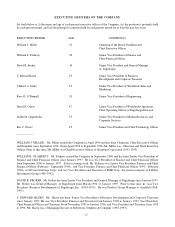Avid 1996 Annual Report Download - page 7
Download and view the complete annual report
Please find page 7 of the 1996 Avid annual report below. You can navigate through the pages in the report by either clicking on the pages listed below, or by using the keyword search tool below to find specific information within the annual report.6
As a result of these changes, the Company expects to increase its support of top customers while also increasing the
proportion of revenues generated through its indirect channels.
The Company maintains sales offices in 32 cities in 17 countries and has relationships with more than 500 distributors,
VARs and dealers throughout the world.
Pro Tools III and other Digidesign-developed products are sold generally through dealers and distributors. Because this
channel tends to focus on music-related products, there is, currently, little overlap between this channel and Avid’s video,
film and broadcast market sales channels.
Avid restructured its customer service function in 1996 to provide improved service and a broader array of service offerings
to its customer base. Avid currently provides direct customer support through regional telephone support centers and field
service representatives in major markets. Support offerings include up to 24-hour, seven day per week options for both
telephone support and on site representation, hardware replacement and software upgrades.
Customer training is provided directly by Avid and through a network of 37 authorized third-party Avid training centers in
10 countries.
Manufacturing and Suppliers
Avid’s manufacturing operations consist primarily of the testing of subassemblies and components purchased from third
parties, the duplication of software and the configuration, assembly and testing of board sets, software, related hardware
components, and complete systems. Avid relies on independent contractors to manufacture components and subassemblies
to Avid’s specifications. Avid’s systems undergo testing and quality assurance at the final assembly stage.
The Company is dependent upon sole source suppliers for certain key components used in its products. Products purchased
by the Company from sole source vendors include computers from Apple and SGI; video compression chips manufactured
by C-Cube Microsystems; a small computer systems interface (“SCSI”) accelerator board from ATTO Technology; a 3D
digital video effects board from Pinnacle Systems; and application specific integrated circuits (“ASIC”) from AMI and LSI
Logic. The Company purchases these sole source components pursuant to purchase orders placed from time to time. The
Company also manufactures certain circuit boards under license from Truevision, Inc. The Company generally does not
carry significant inventories of these source components and has no guaranteed supply arrangements. These purchasing
arrangements can result in delays in obtaining products from time to time. No assurance can be given that sole source
suppliers will devote the resources necessary to support the enhancement or continued availability of such components or
that any such supplier will not encounter financial difficulties. While the Company believes that alternative sources of
supply for its sole source components could be developed, its business and results of operations could be materially
adversely affected if it were to encounter an interruption in its sources of supply.
Avid has manufacturing facilities in Tewksbury, Massachusetts, Dublin, Ireland and Palo Alto and Menlo Park, California.
Research and Development
Avid’s research and development efforts currently are focused on 1) the development or enhancement of digital media content
creation tools that operate on Apple computers on which the Company has traditionally relied, as well as on Unix-based and
Windows-based computers; 2) the development of hardware and software enhancements and additions to its existing video,
film and audio editing systems, and digital news gathering and newsroom computer systems that lower Avid’s costs; 3) the
development of hardware and software enhancements and additions to its existing video, film and audio editing systems, and
digital news gathering and newsroom computer systems to meet additional needs of the professional production, post-
production, and broadcast news markets; 4) AvidNews, a next generation newsroom computer system intended to integrate
standard text-based newsroom computer system functionality with nonlinear video and audio functionality; and 5) the
development of new media storage solutions. The Company undertakes research and development activities in Tewksbury,
Palo Alto, Madison, Wisconsin, and London, England.
Competition
The markets for Avid’s products are highly competitive and subject to rapid change. Competition is fragmented with a large
number of suppliers providing different types of products to different markets.


